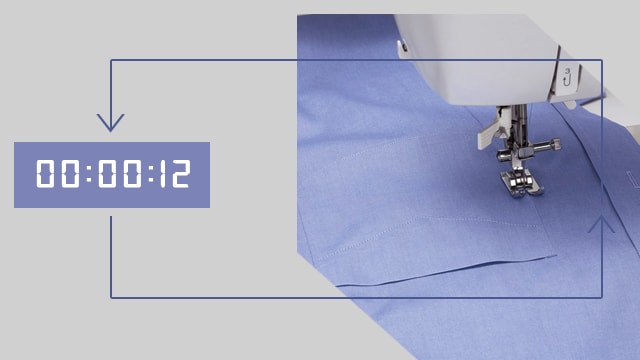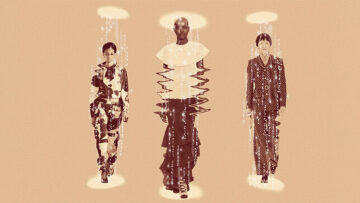Sewing pocket on the front placket of a formal shirt involves three processes starting from hemming of pocket mouth followed by creasing of pocket and finally the attachment of the pocket to left front panel. Each level of technology is suited to the needs of different companies with distinct requirements. The SAM of the operation may vary according to the changes in styling of the pocket, operator’s skill level and type of machine used. While the process of pocket hemming for all the three levels is done on a basic lockstitch machine, the process of creasing and attaching the pocket has been automated, reducing manual operation to its minimum.
Team StitchWorld discusses different levels of technology solutions available for shirt pocket attaching operation.
Part Preparation
Pocket mouth hemming: Common to all levels
Hemming of pocket is done to give finished look to top of the pocket and make it more aesthetically appealing. This process is done using a single needle lockstitch machine. Loading the pocket on the sewing machine, hemming and disposing the piece is done manually, making it dependent on the operator’s skill for the quality of the stitch. For a basic men’s formal shirt, the total cycle time of the operation, performed by a skilled operator is calculated up to 16.8 seconds. Therefore, a total of 1714 pockets can be hemmed in 480 minutes or 8 hours.
GC6150M by Typical and JK-8995D by Jack are two of the top single needle lockstitch machines available in the market.
Basic level of technology: Pocket Creasing by Iron + Pocket Attach by SNLS with UBT
Machine: Flat iron table with steam iron
Subsequent to the process of hemming, the pocket is creased from all the edges, before stitching it to the shirt front panel. The process is performed manually by an operator on a flat iron table with a steam press. Creasing is a very skill based process as improper creasing can lead to a deformed shape of the pocket. All the sides, except the top which is already hemmed, are folded either manually or using a template and is then set with the help of a steam press. The total cycle time of the operation is 32.5 seconds, generating an output of 886 creased pockets in 8 hours.
TIV by Tanger, RV 4425-65 by Ramsons and FB-700SID by Naomoto are some of the examples of such vacuum flat iron tables.
Pocket Attachment
A semi-automatic sewing machine with underbed trimmer, needle positioner and back tack programming facility is required to stitch the hemmed and creased pocket on to the shirt. Operator first aligns the pocket with shirt front mark and then slides under the presser foot and finally starts sewing with auto back tack holding the edge of the pocket and stopping accurately at each corner and pivoting manually. After the automatic back tack and thread cutting, the operator unloads the panel from the workstation. The entire process takes around 51.6 seconds.
Different models are available with three types of machine head lubrication – minute lubrication, semi-dry head and fully-dry head. The minute lubrication technology helps prevent oil stains on the material being sewn; the only main source of oil stains is the frame. The semi-dry head type sewing machine comes with a frame which does not need lubrication, while the fully-dry head type sewing machine is an even further evolved dry-head type which comes with a frame and a hook section which do not need lubrication. The speed varies from 4000 to 5000 sti/min with maximum stitch length of up to 5 mm.
This process is performed using a single needle lockstitch machine. DDL-9000B by Juki is one such example available in the market.
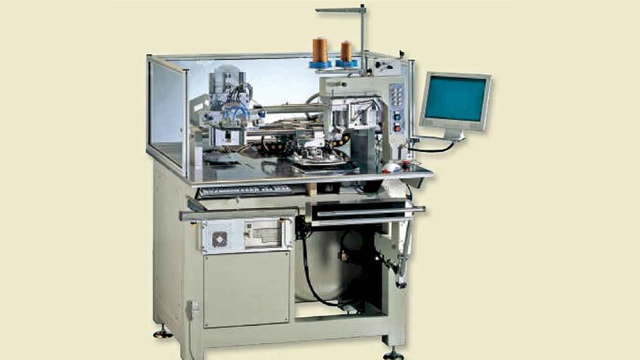
Intermediate level of technology: Pocket Creasing by Pocket Creasing Press + Pocket Attach by SNLS with Ply sensor
While the process of hemming of the pocket is performed as a routine, using a single needle lockstitch machine as discussed earlier, the pocket creasing process begins with the creasing operation performed in a specially designed pocket creasing machine. The operator loading the pocket piece on the machine actuates the machine to perform creasing and then removes the creased pocket from the template and the entire process takes up to 10.2 seconds, reducing operation time when compared to manual operation to a great extent.
Nowadays, one can choose from models either with one work station that is one pocket creaser or with two. The operator when using single pocket creaser is idle for 5-6 seconds when the machine is creasing and pressing one pocket, whereas in case he is using models with two work stations, the output is doubled, eliminating operator’s idle time. For checks and stripes fabrics, a laser guide is present in some models.
NS-9084 by NgaiShing and TUP-2 by Veit are some of the best examples of automatic pocket creasing press.
Comparison of cycle time for the three technology levels: Basic, Intermediate and Advanced |
|||||
| Level | Hemming | Creasing | Attaching (to shirt front panel) | Total time (creasing & attaching) | Production per 8 hours |
| Basic | 16.8 sec | 32.5 sec | 51.6 sec | 84.1 | 342 pcs |
| Intermediate | 16.8 sec | 10.2 sec | 35 sec | 45.2 | 637 pcs |
| Advanced | 16.8 sec | - | - | 12.0 | 2400 pcs |
Pocket Attachment
A semi-automatic sewing machine with underbed trimmer and ply sensor technology is a great solution to attach pocket. The machine comes with a ply sensor technology, which automatically senses the difference of ply and stops immediately at the corner of pocket. It supports the operator’s handling with programmed operating cycles or with automatic sewing stops after the sewing direction has changed. Due to this aid in sewing, an operator can attach the pocket to the front panel quicker than a UBT step programming machine. The total time required to stitch a patch pocket is 35 seconds, while the actual sewing takes only 25.8 seconds, rest 9.2 seconds is taken up for loading and unloading of the shirt panel, that is, one can achieve an output of 822 panels in 480 minutes.
Use of step programming in attaching patch pocket is practically not feasible due to slight variation in creased pocket measurement which may require one or two stitches more or less than standard. The ply sensor technology is best suited as the sensor senses the difference of plies and stitches exactly to the corner of creases. Operators only need to pivot at corners, thereby deskilling the operations while improving productivity.
Maximum sewing speed in some models can go up to 4500 sti/min and is equipped with an edge stitching foot. The availability of a touch screen control panel ensures simple operation of selecting stored programs for various applications such as altering or programming stitch length, speed and patterns.
2483 by PFAFF is one such latest model for attaching pockets to the shirt front panel.
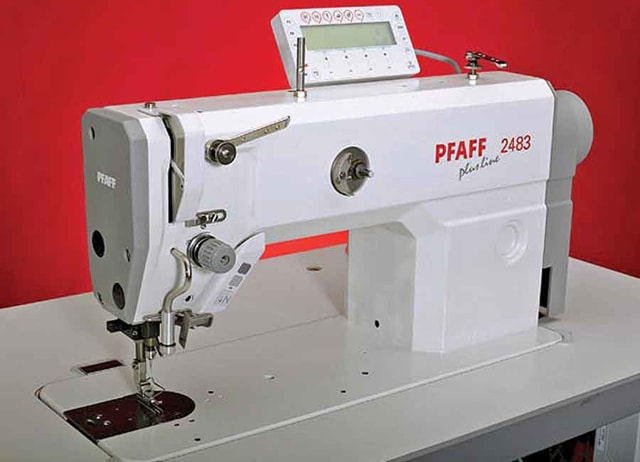
Advanced level of technology: Programmable automatic pocket setter
Nowadays the highly automated factories ask for programmable automated pocket setter in which a pre-hemmed pocket is loaded to the machine and machine first creases the pocket followed by automatically attaching to front panel without any operator intervention. Among the process of loading, sewing and disposing; loading generally remains manual operation, while sewing and dispose of are mostly mechanized. However, mechanization of sewing and/or dispose of operations leads to some idle time of sewing operator which can be utilized for operating a second machine, thereby doubling the labour productivity.
For pocket attachment process, the manufacturers have come up with state-of-the-art workstations, which can perform both the operations of creasing and stitching in a cyclic principle, saving on extra machine and operator required for creasing. Apart from reducing the operation time, the workstations are equipped with touch screen control panels with memory card reader, for storing designs for future references.
The sequence of operations is as follows:
1. The operator loads the shirt panel;
2. The operator loads the pocket piece (pre-hemmed);
3. The operator presses the actuator ;
4. The machine first creases the pocket;
5. Another head then places the creased pocket over shirt panel and carries to sewing head;
6. Sewing of pocket;
7. Stacking of sewn piece.
As described, [1] to [3] is loading operation by operator, [4] & [5] is creasing and aligning by machine, [6] is actual sewing operation and [7] is unloading operation.
There are various automated workstations available in the market for the pocket attaching operations. Though the sequence of operations remains the same, the time taken to complete each step is different in every model. Considering the least time taken, the entire process right from picking, loading, creasing, sewing and disposing takes a minimum of 18 seconds and due to overlapping actions within the workstation, the rate of production is 12 seconds per pocket attach, giving an output of 2400 pockets per 8 hour.
The workstation is equipped with a touch screen panel which displays all machine parameters in easily understandable symbols. An option of style kits is given to the customer, with which one can even use the machine to attach pockets and flaps in one operation. Equipped with a vacuum device, the machine can easily handle striped and checked fabrics as per pattern directly at the sewing unit. In some models, instead of a vacuum device, a laser device is present which imparts laser lines onto the panel for the ease of aligning the pocket on the shirt placket. Maximum sewing speed in such workstations is 4000 s.p.m. achieving a maximum stitch length of 3.5-5 mm.
3588 by PFAFF, 806N by Duerkopp Adler and UAM 01 by Maica are some fine examples of workstations available in the market.
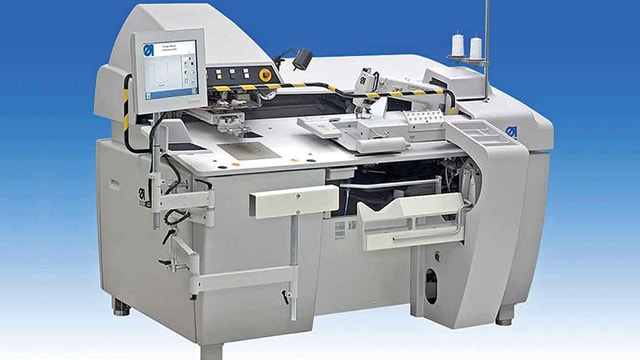
Without delving into the absolute pay back period, it is clear why Intermediate and Advanced Level of technology is not so popular among the manufacturers. While Basic Level gives Return On Investment within 2 months, the Intermediate Level takes approximately 8 months and Advanced Level is even worse at 17 months. The reason/constraint behind low adoption of Advanced Level technology is first, difficulty in handling dimensional unstable fabric (unlike trouser and jeans); and secondly, stripe matching requirement in shirt pocket attaching. However, manufacturers may explore the intermediate option wherein dimensional unstable fabrics can be easily handled and stripe matching can be easily done by the operators.
Return On Investment analysis of the technologies available for Shirt front pocket attachment |
|||||||
Patch Pocket Attachment | Basic Level | Intermediate Level | Advanced Level | ||||
| Type of operation | Pocket Attach | Pocket Crease | Combined: Crease + Attach | Pocket Attach | Pocket Crease | Combined: Crease + Attach | Combined: Crease + Attach |
| CM price of the shirt (Rs.) assumed | 101 | 101 | 101.00 | 101.00 | 101.00 | ||
| Total SAM (minutes) assumed | 29 | 29 | 29.00 | 29.00 | 29.00 | ||
| Total sewing cost (Rs.) | 75.4 | 75.4 | 75.40 | 75.40 | 75.40 | ||
| SAM for creasing and attaching process (sec) | 51.6 | 32.5 | 35.00 | 10.20 | 12.00 | ||
| CM price per operation (Rs.) | 2.24 | 1.41 | 1.52 | 0.44 | 0.52 | ||
| SAM value for single operation (sec) | 51.60 | 32.50 | 35.00 | 10.20 | 12.00 | ||
| Production per day (shift of 8 hours) | 558.14 | 886.15 | 886.15 | 2823.53 | 2400.00 | ||
| Working days in a month | 26.00 | 26.00 | 26.00 | 26.00 | 26.00 | ||
| Months in a year | 12.00 | 12.00 | 12.00 | 12.00 | 12.00 | ||
| Production per annum (pieces) | 174139.53 | 276480.00 | 276480.00 | 880941.18 | 748800.00 | ||
| CM price per operation (Rs.) | 2.24 | 1.41 | 2.24 | 1.41 | 3.64 | ||
| Cost output/annum (Rs.) | 389376.00 | 389376.00 | 618209.28 | 1242127.06 | 2725632.00 | ||
| Production target (pieces per day) | 2400.00 | 2400.00 | 2400.00 | 2400.00 | 2400.00 | ||
| No. of machines required | 4.30 | 2.71 | 2.71 | 0.85 | 1.00 | ||
| Cost of one machine (Rs.) | 47154.00 | 21000.00 | 450142.42 | 616000.00 | 4355497.60 | ||
| Cost of total machine (Rs.) (T) | 202762.20 | 56875.00 | 1219135.72 | 523600.00 | 4355497.60 | ||
| Annual depreciation (%) | 15.00 | 15.00 | 15.00 | 15.00 | 15.00 | ||
| Depreciated value of m/c after one year (Z) | 172347.87 | 48343.75 | 220691.62 | 1036265.36 | 445060.00 | 1481325.36 | 3702172.96 |
| Cost of one operator per month (minimum wage) | 6000.00 | 6000.00 | 5500.00 | 5500.00 | 5500.00 | ||
| Total operators salary (Y) @ 12 months | 309600.00 | 195000.00 | 178750.00 | 56100.00 | 66000.00 | ||
| Total KwH consumption per year | 3434.50 | 2502.73 | 1555.75 | 3182.40 | 2496.00 | ||
| Electricity cost per year (Rs.) (W) | 17172.48 | 12513.65 | 7778.75 | 15912.00 | 12480.00 | ||
| CM price from total machines (X) | 1674316.80 | 1054560.00 | 2728876.80 | 1674316.80 | 1055808.00 | 2730124.80 | 2725632.00 |
| Cash Inflow (I = X-Y-W) (Rs.) | 1347544.32 | 847046.35 | 2194590.67 | 1487788.05 | 983796.00 | 2471584.05 | 2647152.00 |
| ROI for the first year (X-Y-W)/Z (%) | 781.87 | 1752.13 | 994.42 | 143.57 | 221.05 | 166.85 | 71.50 |
| Total pay back period in months | 1.21 | 7.19 | 16.78 (1 yr 5 months) | ||||

